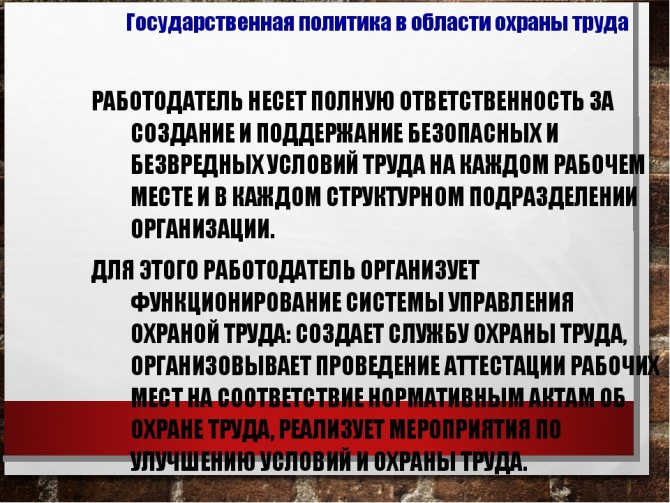The employer's policy in the field of labor protection is a public declaration of the employer's intentions to fulfill obligations to ensure state regulatory requirements for labor protection (see Order of the Ministry of Labor 438n dated August 16, 2016).
Employer's labor protection policy sample
In the occupational safety and health policy, the organization specifies its occupational safety and health goals and what obligations it undertakes to achieve these goals.
For example, the declared goal is to prevent occupational diseases. To do this, the employer undertakes to consult with employees on labor protection, conduct risk assessments in the workplace, train employees, etc. Well, to achieve these goals, along with the occupational safety policy, another document is being developed: the “Occupational Safety and Health Action Plan,” which clearly states what will be done and when.
The employer's policy in the field of labor protection is an integral part of the labor protection management system (OSMS), which the employer of any organization in Russia is obliged to provide in accordance with Art. 212 Labor Code of the Russian Federation.
The policy must be issued in the form of a separate local document of the organization, or be one of the sections of the OSMS.
The occupational safety policy must be available to all employees of the enterprise! Therefore, it is advisable to prepare it on 1-2 pages and post it on the organization’s website, at a stand or occupational safety corner.
Normative documents for policy development
— Order of the Ministry of Labor of the Russian Federation No. 438n dated August 19, 2016 “On approval of the Standard Regulations on the Occupational Safety and Health Management System.”
— GOST 12.0.230-2007 System of occupational safety standards (SSBT). OT management system. General requirements.
— GOST R 12.0.007-2009 System of occupational safety standards (SSBT). OSH management system in the organization. General requirements for development, application, evaluation and improvement.
— Article 210 of the Labor Code of the Russian Federation “Main directions of state policy in the field of labor protection.”
How to apply (sample)
An example and sample of such an act for a company from any sector of economic activity must contain mandatory information and consist of several sections:
- the current state of compliance with labor safety standards;
- main areas of activity to improve efficiency and measures taken in this area;
- plans to improve the regulatory and application framework to improve the state of the industry as a whole;
- the name and initials of the position of the person who signed this act;
- serial number of the internal document and the date of its adoption;
- dates of entry into force and duration of validity in time.
Stages of policy development in the field of occupational safety and health
Conventionally, the creation of a labor protection policy can be divided into several stages:
1) Preliminary analysis of the state of labor protection in the organization
The analysis includes checking the compliance of labor protection issues with legal requirements and assessing the hazards that may arise during the work process at each of these stages.
In practice, to conduct a preliminary analysis, the employer and occupational safety officer hold a meeting of workers to discuss which occupational safety issues will be included in the policy. Based on the results of the meeting, a protocol must be drawn up.
The results obtained will be the starting point against which future policy outcomes will be compared.
2) Direct concept of labor protection
Based on the results of the analysis, policies are developed aimed at improving and improving the current state of labor protection. It is its provisions that determine the further vector of development of the organization in this direction.
3) Goals
The final result of the implementation of the policy in the field of labor protection is the setting of certain goals and deadlines for achieving these goals.
4) Achieving goals
The policy must detail the mechanism for achieving the intended goals, as well as correctly distribute duties and responsibilities “on the path to the goal.”
An assessment of the effectiveness of policy implementation will be a comparative analysis with that very “starting point”, that is, the primary analysis of the state of labor protection.
What to pay attention to when drawing up
In the process of document formation, it is necessary to pay attention to a number of aspects:
- taking into account the legitimate rights and interests of all parties, in particular employees;
- compliance with the fundamental norms of existing legislation;
- writing down significant provisions and aspects in the document.
The easiest way during the development process is to use a ready-made template and adapt it to the personal needs of the enterprise. It is important to monitor the composition and structure of the document. It should include:
- company name;
- a list of information about its activities;
- description of principles and goals;
- taking into account basic directions;
- list of actions to ensure provisions;
- Name and signature of the manager.
What goals should be stated in the policy?
The main objectives of the labor protection policy, the implementation of which the employer undertakes, may be:
- striving for zero injuries, preventing accidents and occupational diseases;
- promise to follow the requirements of the Labor Code and other regulations on labor protection
- the obligation to agree with workers and their representative body on labor protection measures, which require taking into account their opinions;
- work on the implementation of a system for improving labor protection.
Key principles and goals
The key objectives of such an act, as applied to an individual enterprise, regardless of industry, include:
- minimizing injuries and harm from emerging emergency situations;
- maintaining and improving the material base to ensure proper control and supervision in this area;
- preserving the right of citizens to decent work;
- providing employees with all necessary protective equipment, both during work and in the event of an accident.
Compliance with these principles guarantees the legitimate implementation of such a concept and an overall increase in operational efficiency.

Distribution of responsibilities among subjects of labor relations in the field of policy implementation
What should an employer's occupational safety and health policy ensure?
Let us study in detail the provisions of Order No. 438n, which states that the labor protection policy ensures:
a) the priority of preserving the life and health of workers in the process of their work;
This priority is fixed at the legislative level and is one of the fundamental principles on the basis of which the entire labor protection system in any organization is built.
b) compliance of working conditions at workplaces with labor protection requirements;
In addition to the fact that this procedure is fixed at the state level, adherence to this principle allows not only to avoid a fine, if we consider this issue in terms of compliance with the law, but also prevents the development of occupational diseases and injuries in the workplace.
c) implementation of consistent and continuous measures (measures) to prevent accidents and cases of deterioration in the health of workers, industrial injuries and occupational diseases, including through occupational risk management;
This point implies not only formal compliance with legislation in the field of labor protection, but also the constant improvement of processes within the organization, which will reduce negative situations to a minimum or eliminate their occurrence altogether.
d) taking into account the individual characteristics of workers, including through the design of workplaces, selection of equipment, tools, raw materials and supplies, personal and collective protective equipment, design of production and technological processes;
An individual approach is always preferable, and labor protection issues are no exception. The more factors are taken into account, the more detailed a particular issue is studied, the more effective a solution can be selected.
e) continuous improvement and increase in efficiency of the occupational safety management system;
Occupational safety management is constantly being improved, and accordingly, the employer's policy on occupational safety issues is also being improved. Achieving new goals, changes in legislation, changing the field of activity and many other factors - all this affects labor protection, and it must take into account all current changes.
f) mandatory involvement of workers and representative bodies authorized by them to participate in the management of labor protection and ensuring working conditions that meet labor protection requirements, through the necessary resource provision and encouragement of such participation;
Any employer initiative will not be effective without receiving feedback from employees, whose working conditions, in fact, are the focus of the organization’s policy. It is their suggestions, reviews, criticism and other forms of communication that allow the employer to understand how well and correctly the organization’s policy in the field of labor protection is being implemented.
g) personal interest in ensuring, as far as possible, safe working conditions;
In any organization, the approach to labor protection should not be formal “for show” or aimed only at eliminating the possibility of receiving fines. Self-discipline of employees in matters of labor protection should come first. If the employer’s approach is formal, then the attitude of the employees will be corresponding. If the employer really carries out high-quality work in terms of labor protection, is in constant interaction with employees regarding these issues, then they will feel the importance of this aspect of their work and their attitude will be more responsible.
h) fulfillment of other duties in the field of labor protection based on the specifics of their activities.
Many employees are responsible for entire stages in the organization’s work, and sometimes to ensure full control it is necessary to attract additional forces, including employees who are well acquainted with these stages. Building a system of control, training, and so on with the correct distribution of responsibilities is more effective than working according to so-called “templates.”
The company is aware of its responsibility for preserving the life and health of participants in its production activities.
Company goals:
- creation of healthy and safe working conditions by achieving a level of production processes that corresponds to the current state of technology and scientific achievements, including the obligatory conduct of internal examination for compliance with safety requirements of pre-project and design solutions, as well as guided by the principle of priority of the life and health of workers relation to the results of production activities;
- formation of a sustainable motivational mechanism for safe behavior at work among the Company’s employees, development of people’s skills to anticipate and prevent the occurrence of incidents at work.
To achieve its goals, the Company solves the following tasks:
- increases the level of industrial safety of the Company's facilities by ensuring reliability, safe and trouble-free operation of process equipment;
- ensures the reduction of risks, including dangerous and harmful production factors associated with the possibility of causing damage to the life and health of workers, in practical activities it moves from the practice of “accident investigation” to “incident analysis, risk management in the actions of personnel, working conditions, equipment condition ";
- improves the occupational health and safety management system based on the standards of PJSC MMC Norilsk Nickel, adapted to the specific production conditions of the Company;
- increases the efficiency of production control of compliance with labor protection and industrial safety requirements;
- develops and stimulates the personal and collective responsibility of the Company’s employees for compliance with labor protection and industrial safety requirements;
- promotes and carries out the widest possible implementation of best practices, Russian and foreign, on the issue of forming among the Company’s employees a sustainable motivational mechanism for safe behavior at work, responsibility both for their own life and health, and for the life and health of those working next to them.
The company undertakes in the field of labor protection and industrial safety:
- ensure compliance with the requirements of Federal and regional legislation, international agreements, requirements of industry standards and regulations governing the Company’s activities in the field of labor protection and industrial safety, as well as other requirements that the Company has agreed to comply with;
- carry out identification, assessment and regulation of production risks, special assessment of working conditions and based on their results, develop and implement programs aimed at preventing accidents and occupational diseases;
- to consistently involve all Company personnel in active participation in activities related to industrial safety, labor protection and health, and to improve measures to stimulate this participation;
- introduce continuous systems for training Company personnel in safe labor practices, form strong behavioral attitudes towards compliance with labor safety requirements;
- ensure continuous improvement of the functioning of the occupational health and safety management system, considering it as one of the components of a sustainable competitive advantage;
- ensure the protection of the Company’s personnel from the influence of negative production factors, introduce effective work and rest regimes, improve social and living conditions at work, introduce effective means of collective and individual protection;
- implement compensation measures aimed at compensating the Company’s personnel for damage caused by exposure to unfavorable working conditions, carry out rehabilitation of employees in case of accidents at work and in the event of occupational diseases, implement special health improvement and sanatorium treatment programs for employees;
- review, adjust and improve, as necessary, the Company’s policy in the field of labor protection and industrial safety;
- implement this Policy on the principles of social partnership within the framework of direct dialogue between the employer and employees.
05.10.2016
General Director, S. V. Lipin
- < Back
- Forward >
What should be reflected in the labor protection policy?
The policy reflects:
a) provisions on compliance of working conditions at the employer’s workplace with labor protection requirements;
b) the employer’s obligations to prevent injuries and deterioration in the health of workers;
c) provisions on taking into account the specifics of the employer’s activities and the type(s) of economic activity carried out by him, which determine the level of professional risks of employees;
d) the procedure for improving the functioning of the occupational safety management system.
All this is done thanks to control and high-quality implementation of labor protection measures by the employer. However, he does not implement all this alone, but through the mechanisms that he has within the organization. It is policy development that guides the operation of these mechanisms.
CONCLUSION:
Thus, the occupational safety policy is a mandatory document in which the employer declares what activities it will take as part of the continuous improvement of the occupational safety and health system. Its correct development and, most importantly, implementation make it possible to achieve high results, the indicator of which will be a reduction in negative impacts on employees during their work activities.
We also recommend reading:
- Types of labor safety briefings
- Model regulations on the occupational safety management system
- Labor safety engineer training
- Changes in labor protection legislation in recent years
Please rate the site or material!
( 2 ratings, average: 5.00 out of 5)
How it is developed at the enterprise - main directions
The development of such material in an organization is usually carried out by an occupational safety specialist or the head of such a full-time unit. The creation of the concept must take into account the experience of related industry companies; regulatory government elements must be taken into account. The statement includes provisions on cooperation with government bodies, the priority of the rights and freedoms of citizens in the implementation of their work activities.
Important ! The development is carried out taking into account the rules, standards and GOST for document flow and office work. The concept is issued in the form of a local document and signed by the head of the organization. It extends its legal force to all employees without exception, and must manage only within its competence.





